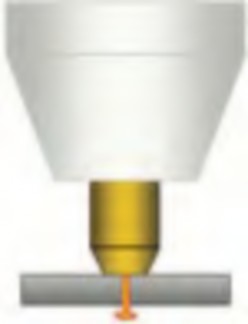
Plasma cutters come very close to fulfilling that saying. One of the natural forms of plasma is lightning; and scientists have figured out how to create plasma in a torch handle (does that count for a bottle?). There are several good reasons for owning a plasma cutter.
1. It can cut things an oxy-fuel torch can’t cut: stainless steel and aluminum.
2. It requires no preheat cycle, the heat zone is minimized, and it produces a clean cut.
3. It doesn’t require exotic gases to create the plasma: compressed air will do the trick.
4. Manufacturers of plasma cutting machines are turning out better machines; they are smaller, more powerful and best of all, better priced.
With the correct tips, plasma cutting can be fun or serious. But you can shorten the life span of the tip and/or distort the cut by ignoring manufacturer’s recommendations. The fun in owning plasma can be seen on the many YouTube videos. But it can also be a serious work tool: pierce, bevel, cut holes and even do gouging. Whatever tip you use, use it for the amperage it was rated for. The orifices were designed to handle certain amps.
Applying too much amperage will lead to distorting the orifice and insufficient amps will give you the cut you didn’t want. The killer for plasma tips is moisture especially with compressed air. But a good filter on your airline will help keep the moisture out.

The Drag tip is for cutting light gauge metal up to ¼”. It produces the best quality cut, a narrow kerf, and fast cutting speed. If you can make a template out of non-conductive material you can allow the tip to trace your cut (ie. your tip is in contact with the work piece)

The Standoff tip can be used for cutting thicker cuts and current levels of 60 amps. The standoff is going to keep the tip off the work piece. Being away from the work piece is going to prevent build up of slag and splatter – getting you a longer life span of the tip.

Drag Shield cutting tip is a friendly method for between 70- 100 amps. Keeping a constant distance from your work piece. The drag shield rests on the work piece but uses a special shield to prevent build up and slag. You can also use templates for straight lines or patterns.

Gouging Tips plus tilting the torch head on a 35-45 degree angle will allow you to gouge. There are different tips you can get that will suit your gouging needs: the width of your cut and depth of your cut.
Cheers,
Ron-Son’s Torch